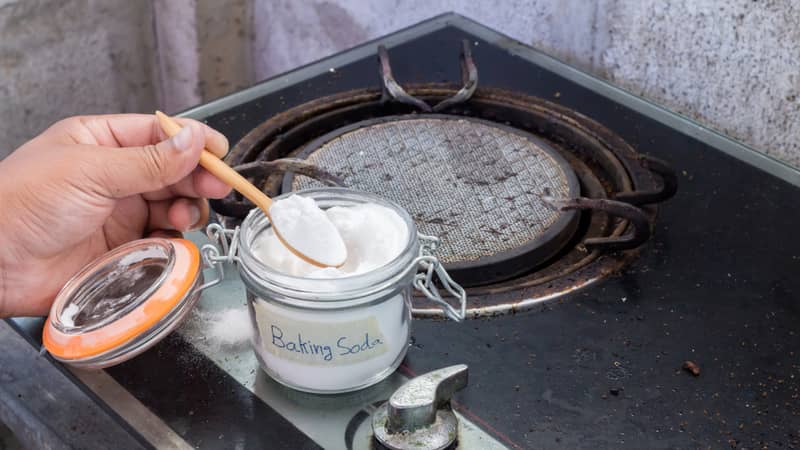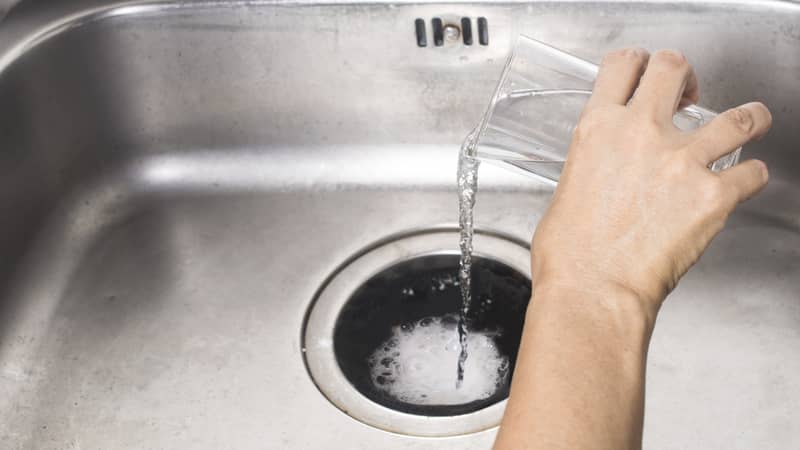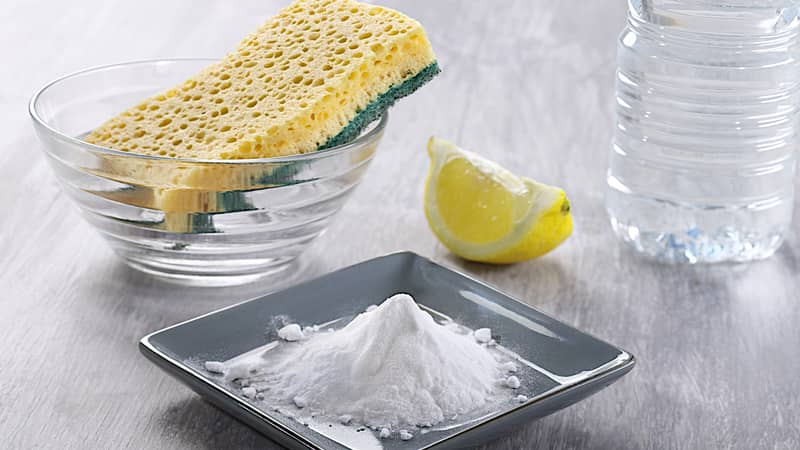Bicarb soda, also known as baking soda, is a miracle worker when it comes to cleaning.
This humble ingredient in most kitchen cabinets can tackle many household tasks.
So, let’s explore everything you can clean with bicarb soda and discover why this pantry staple is a favourite tool of many expert cleaners.
Is Bicarbonate Soda the Same as Baking Powder?
Before we delve into the top ways to clean with bicarb soda, let’s quickly discuss baking soda vs baking powder.
Baking soda and baking powder are different despite having similar names and ingredients.
Baking soda is purely an alkaline compound that reacts when it comes into contact with acids.
This reaction creates bubbles of carbon dioxide, which can be useful for various cleaning tasks.
On the other hand, baking powder contains both an acid and a base (baking soda) and has different cooking uses.
The Top Ways To Clean With Bicarb Soda
Bicarb soda’s cleaning power is so versatile that it can practically do everything – from deodorising your fridge to scrubbing your bathroom clean.
Its unique chemical properties make it a potent cleaner, capable of tackling various tasks around the house.
So, what can you clean with baking soda?
- Eliminate bad smells
- Clean bathrooms
- Clean bedrooms
- Clean kitchens
- Clean upholstery and carpets
- Clean appliances
- Remove grime and rust
- Unclog drains
- Remove laundry stains
- Brighten yellowed pillows
- Clean garden furniture
- Clean and polish cutlery
Prevent or eliminate bad smells
For the kitchen

Everyday kitchen items such as sponges or plasticware can get really smelly with use.
Sprinkling baking soda on kitchen surfaces, such as a chopping board, and scrubbing them can help remove any lingering smells.
For difficult stains and odours on plasticware, it’s recommended that you make a mixture of hot water and baking soda and let it soak overnight.
For the bedroom
Keep your closet and drawers fresh by placing a small jar or cloth bag of baking soda inside.
This will absorb odours and keep musty smells at bay.
For the rubbish bin
This is one of the most overlooked places when cleaning a house.
Keep your rubbish bin free from funky smells by sprinkling a small amount of bicarb soda in it once a week.
This is especially useful in the kitchen bin, as baking soda is powerful enough to absorb more pungent smells.
Clean your bathroom

Rubbing baking soda with a rag or sponge is a fool-proof way of removing soap scum and keeping your bathroom clean.
You can use baking soda, aka bicarbonate of soda, to clean toilets, shower curtains, bathroom fixtures, bathtubs, shower doors, tiling and more.
Need help with cleaning tile grout? Mix lemon juice and bicarb soda to form a paste you can brush along the grout lines. Leave it on for a few minutes, then simply wipe it off.
If you need something a bit stronger, you can use bleach as an alternative to lemon juice.
Clean bedrooms with ease
Baking soda can be a game-changer in maintaining a fresh and clean bedroom.
To refresh musty mattresses, sprinkle a generous amount of baking soda over them and let sit for at least an hour or overnight to absorb odours and moisture.
Vacuum the powder away to reveal a fresher surface.
If your bedroom has tarnished picture frames, a baking soda and water paste can restore their shine.
Clean the kitchen without bleach
You can clean your kitchen effectively by incorporating bicarb soda into your cleaning routine.
It’s cost-efficient and eco-friendly, making it a great alternative to chemical cleaners.
Surfaces and benchtops
Bicarb soda is a mild abrasive, which makes it perfect for cleaning kitchen benchtops and other surfaces.
To clean your benchtops, sprinkle some bicarb soda on a damp cloth or sponge and scrub the surface.
Once done, rinse with warm water and wipe it dry.
Stovetop and oven

Burnt-on food can be tough to remove from kitchen appliances and surfaces.
But with bicarb soda, cleaning your stove top and oven becomes easy.
Sprinkle bicarb soda on the stained areas and let it sit for 15–30 minutes.
Scrub gently with a cloth or sponge and wipe it clean.
For stubborn stains, let the bicarb soda settle overnight and scrub it clean the following day.
Sink and drains
To clean your kitchen sink and drains, pour half a cup of bicarb soda down the drain, followed by half a cup of white vinegar.
Let it bubble for 15–20 minutes, then rinse with boiling water.
This process will not only clean your drains, but also unclog them.
Microwave

Cleaning the microwave can be a hassle, but bicarb soda can simplify this task.
Mix two tablespoons of bicarb soda with a cup of water in a microwave-safe bowl, and heat it for three minutes.
The steam will help loosen food splatters, and the bicarb soda will help deodorise the microwave.
Once the bowl cools down, use the liquid to clean the microwave’s interior.
Refrigerator
Bicarb soda is excellent for eliminating odours.
To freshen up your fridge, open a box of bicarb soda and place it in a corner of your fridge.
Change the box every month for a consistently fresh and odour-free refrigerator.
Pots and pans

To clean pots and pans (and remove burnt-on food!), sprinkle baking soda onto the burnt area and add enough water to form a paste.
Let it sit for a few hours or overnight.
The bicarb soda will break down the burnt food, making it easier to scrub away.
Clean upholstery and carpets
Baking soda is the ultimate natural cleaning solution for cleaning and freshening the carpet.
Not only can it be sprinkled onto the smelly carpet and vacuumed up to dissolve odours, but it is also great for stain removal.
Make a paste or sprinkle it on the stain, then rub it in or blot it with a wet rag or towel. It lifts most stains quickly and easily.
Sodium bicarbonate can also do wonders for cleaning upholstered chairs and other furniture.
Appliance cleaning aid
Bicarb soda is one of the most popular homemade oven cleaners, and for a good reason.
With white vinegar, lemon juice, and a sprinkle of baking soda, you can have a natural cleaner rivalling commercial cleaning sprays!
You can also apply baking soda to a damp sponge to scrub your microwave clean of food residue.
That’s not all. You can make your dishwasher cleaner and fresher with a dash of baking soda at the bottom.
What can’t bicarb soda handle, right?
Rust and Grime Removal

Using bicarb soda (baking soda) to remove rust and grime is an effective and environmentally friendly approach.
Here’s how you can harness its power:
Removing Rust:
- Make a baking soda and water paste: Combine bicarb soda with water in a 3:1 ratio (three parts baking soda to one part water) to create a thick paste. You want the consistency to be spreadable but not runny.
- Apply to the rust: Apply the paste directly onto the rusted area with a cloth or sponge. You can use an old toothbrush to work the paste into crevices and small spaces.
- Let it sit: Allow the paste to sit on the rust for about 20–30 minutes. You can let it sit for a few hours for more severe rust.
- Scrub: After letting it sit, scrub the area with a brush (an old toothbrush or a soft scrubbing brush) using circular motions. The rust should start to lift away from the metal.
- Rinse and Dry: Wash off the paste with water. Ensure you dry the item thoroughly to prevent further rusting.
Removing Grime:
- Wet the surface: Dampen the grimy area slightly with water. This will help the bicarb soda adhere better.
- Sprinkle bicarb soda: Generously sprinkle bicarb soda over the grime. If dealing with vertical surfaces, you can make a slightly thinner paste than the one used for rust removal.
- Scrub gently: Using a sponge or brush, gently scrub the area in circular motions. The abrasive nature of the bicarb soda will help lift away the grime.
- Leave it on: For particularly tough grime, leave the bicarb soda on for 15–20 minutes before scrubbing.
- Rinse with warm water: Wash away the bicarb soda with clean water and dry the surface.
Both rust and grime can be stubborn, so you might need to repeat the process or leave the bicarb soda on longer to achieve the best results.
However, bicarb soda is a gentle abrasive, making it suitable for many surfaces without the risk of causing damage.
Unclog drains

Bicarb soda and vinegar react together to break down grease and grime that clogs your drains.
Pour half a cup of bicarb soda down the drain, followed by half a cup of vinegar.
Wait 15-20 minutes, then rinse with hot water.
Remove tough laundry stains
Bicarb soda can help lift stubborn stains from clothes.
Make a paste with bicarb soda and water, apply it to the stain, let it sit, and then wash as usual.
Brighten yellowed pillows

Mix 1 cup of bicarb soda with the laundry detergent of your choice.
Wash your pillows in this mixture to help restore their original colour.
Clean garden furniture
Make a solution with 1 cup of bicarb soda and 4 litres of water.
Use this solution to scrub down your outdoor furniture and make it look new again.
Clean and polish cutlery
Create a paste with three parts bicarb soda to one part water.
Rub the paste onto each piece of silver, rinse thoroughly, and then dry.
You’ll do the same steps to polish cutlery, but you need to gently rub the paste onto each piece with a soft cloth.
Allow the paste to sit for a few minutes, then rinse each piece thoroughly with warm water.
Dry with another clean, soft cloth, and buff as you go to reveal beautifully polished silverware that looks as good as new.
FAQs About Bicarb Soda Cleaning Hacks
What do you mix with bicarbonate of soda to clean?

Bicarbonate of soda (bicarb soda or baking soda) can be mixed with several other household items to enhance its cleaning power:
- Water: A simple paste of bicarb soda and water can effectively remove stains and act as a mild abrasive for surfaces.
- White vinegar: Combining bicarb soda and vinegar produces a bubbly reaction. This mixture is great for unclogging drains and as a general-purpose cleaner.
- Lemon juice: Lemon juice and bicarb soda can be mixed to create a natural disinfectant and cleaner, suitable for various surfaces and leaving a pleasant, fresh scent.
- Hydrogen peroxide: Combining bicarb soda and hydrogen peroxide can work wonders on tough stains, such as grout or stained white clothing. But be careful when using this substance, as it can discolour or damage surfaces if used incorrectly.
What should not be cleaned with baking soda?
Bicarb soda is a versatile cleaner, but it’s not suitable for everything:
- Aluminium cookware: Baking soda can react with aluminium, making the cookware discoloured.
- Antique silver: While baking soda can polish silver, it can be too abrasive for antique or intricately designed pieces, potentially damaging the finish.
- Some ceramic and glass stove tops: Always check the manufacturer’s guidelines, as the abrasive nature of bicarb soda can leave scratches.
- Hair: Some people try using bicarb soda as a hair cleaner or clarifier. However, its alkaline nature can disrupt the scalp’s pH balance, leading to dryness and potential breakage.
- Wood: Bicarb soda can be too abrasive and might damage the finish on wooden furniture and floors.
Always test on an inconspicuous spot when trying bicarb soda on a new material or surface.

